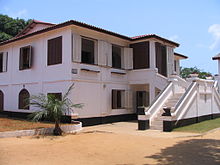São João Baptista d'Ajudá
São João Baptista d'Ajudá was a small Portuguese colonial area on the African Guinea coast . It was located near the city of Ouidah ( Portuguese Ajudá , French Ouidah , English Whydah ) in what is now Benin .
The area of the colony essentially consisted of a trading post and its immediate surroundings, which had been left to the Portuguese by a local ruler. It formed an enclave and was at times the smallest colony in the world with an area of 4.5 hectares.
history
Fort Ajudá was first founded by the Portuguese in 1680, but was later abandoned. With the re-establishment of the station in 1721, the Portuguese intended to re- establish themselves in the Gulf of Guinea . They had been ousted from this area by the Dutch in the course of fierce fighting during the 17th century, mainly through the loss of their most important colonial fortress, Elmina . However, the Portuguese did not succeed in regaining their old supremacy in Guinea trade with the establishment of this trading post. São João Baptista d'Ajudá only played a certain role in the 18th century as the regional center of the slave trade. The fortress was administered by the Companhia de Cacheu e Cabo Verde company and administratively belonged to the Portuguese colony of Brazil . Even after Brazil gained independence from Portugal in 1822, Fort Ajudá formed a colony of Brazil before it was abandoned by the latter in 1844. In 1861 the rulers of Dahomey gave the fort to French missionaries, but in 1865 Portugal was able to reassert its old rights and take possession of the fortress again. The colony was administered from São Tomé and Príncipe . On September 10, 1885, Portugal also signed a treaty with the Kingdom of Dahomey , through which it took over the protectorate over its entire coast in early 1886. In 1892, however, Dahomey fell to France.
Portuguese rule over São João Baptista d'Ajudá lasted until 1961, when this territory was forcibly occupied and annexed by Dahomey (Benin since 1975), which had become independent from France the previous year, on August 1, 1961 (on the anniversary of Dahomey's independence) . The annexation was only recognized by Portugal in 1975. Portugal then funded the renovation of the fort and its conversion into a museum .
Novel setting
The Fort São João Baptista d'Ajudá is one of the main locations of the 1980 novel The Viceroy of Ouidah (English original title: The Viceroy of Ouidah ) by the British writer Bruce Chatwin (1940-1989). It was made into a film by Werner Herzog under the title Cobra Verde .
literature
- John H. Parry: European Colonial Empires , Munich 1972, ISBN 3-463-13686-4 .
Web links
- Article in the Encyclopaedia Britannica
- List of all states and territories
- Description of the location of Fort Ajudá
- Article in the "MyFundi" online encyclopedia
- Ouidah slide show with images of Fort Ajudá
Individual evidence
- ^ The Guinness Book of Records; Guinness Superlatives Limited, London 1958; P. 81: "The smallest colony in the world is the Portuguese enclave in the French West African Territory of Dahomey consisting of the Fort of St. John the Baptist (S. Joao Batista de Ajudá). This has been occupied since 1680 and is garrisoned by one officer and a few men " .
- ^ Brockhaus´ Conversations-Lexikon, 13th edition. Supplementary volume, pages 17 (Africa) and 602 (Portugal). Leipzig 1887
Coordinates: 6 ° 21 '32 " N , 2 ° 5' 24" E


